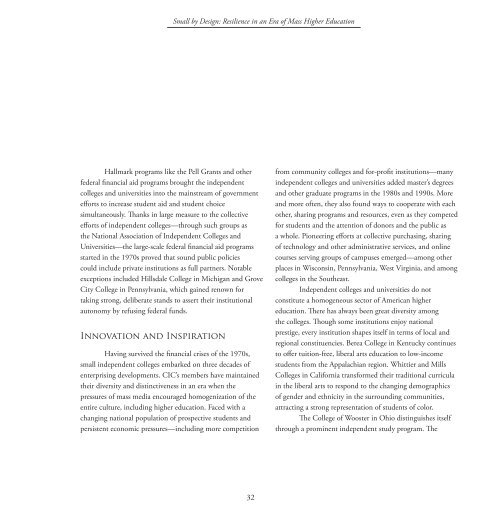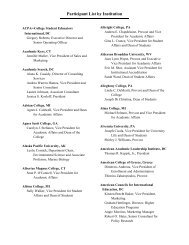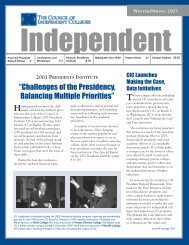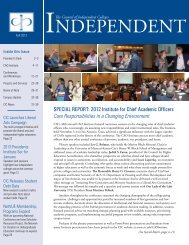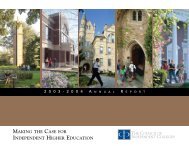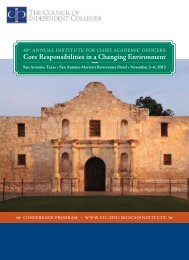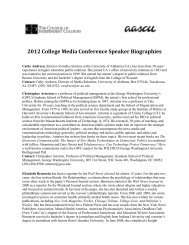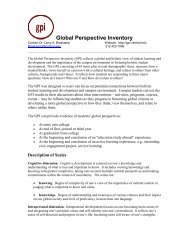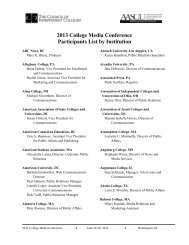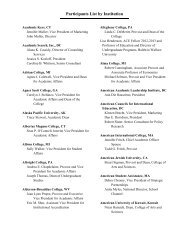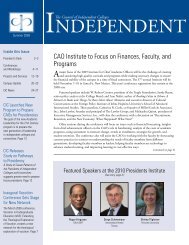Meeting the Challenge: - The Council of Independent Colleges
Meeting the Challenge: - The Council of Independent Colleges
Meeting the Challenge: - The Council of Independent Colleges
You also want an ePaper? Increase the reach of your titles
YUMPU automatically turns print PDFs into web optimized ePapers that Google loves.
Small by Design: Resilience in an Era <strong>of</strong> Mass Higher Education<br />
Hallmark programs like <strong>the</strong> Pell Grants and o<strong>the</strong>r<br />
federal financial aid programs brought <strong>the</strong> independent<br />
colleges and universities into <strong>the</strong> mainstream <strong>of</strong> government<br />
efforts to increase student aid and student choice<br />
simultaneously. Thanks in large measure to <strong>the</strong> collective<br />
efforts <strong>of</strong> independent colleges—through such groups as<br />
<strong>the</strong> National Association <strong>of</strong> <strong>Independent</strong> <strong>Colleges</strong> and<br />
Universities—<strong>the</strong> large-scale federal financial aid programs<br />
started in <strong>the</strong> 1970s proved that sound public policies<br />
could include private institutions as full partners. Notable<br />
exceptions included Hillsdale College in Michigan and Grove<br />
City College in Pennsylvania, which gained renown for<br />
taking strong, deliberate stands to assert <strong>the</strong>ir institutional<br />
autonomy by refusing federal funds.<br />
Innovation and Inspiration<br />
Having survived <strong>the</strong> financial crises <strong>of</strong> <strong>the</strong> 1970s,<br />
small independent colleges embarked on three decades <strong>of</strong><br />
enterprising developments. CIC’s members have maintained<br />
<strong>the</strong>ir diversity and distinctiveness in an era when <strong>the</strong><br />
pressures <strong>of</strong> mass media encouraged homogenization <strong>of</strong> <strong>the</strong><br />
entire culture, including higher education. Faced with a<br />
changing national population <strong>of</strong> prospective students and<br />
persistent economic pressures—including more competition<br />
from community colleges and for-pr<strong>of</strong>it institutions—many<br />
independent colleges and universities added master’s degrees<br />
and o<strong>the</strong>r graduate programs in <strong>the</strong> 1980s and 1990s. More<br />
and more <strong>of</strong>ten, <strong>the</strong>y also found ways to cooperate with each<br />
o<strong>the</strong>r, sharing programs and resources, even as <strong>the</strong>y competed<br />
for students and <strong>the</strong> attention <strong>of</strong> donors and <strong>the</strong> public as<br />
a whole. Pioneering efforts at collective purchasing, sharing<br />
<strong>of</strong> technology and o<strong>the</strong>r administrative services, and online<br />
courses serving groups <strong>of</strong> campuses emerged—among o<strong>the</strong>r<br />
places in Wisconsin, Pennsylvania, West Virginia, and among<br />
colleges in <strong>the</strong> Sou<strong>the</strong>ast.<br />
<strong>Independent</strong> colleges and universities do not<br />
constitute a homogeneous sector <strong>of</strong> American higher<br />
education. <strong>The</strong>re has always been great diversity among<br />
<strong>the</strong> colleges. Though some institutions enjoy national<br />
prestige, every institution shapes itself in terms <strong>of</strong> local and<br />
regional constituencies. Berea College in Kentucky continues<br />
to <strong>of</strong>fer tuition-free, liberal arts education to low-income<br />
students from <strong>the</strong> Appalachian region. Whittier and Mills<br />
<strong>Colleges</strong> in California transformed <strong>the</strong>ir traditional curricula<br />
in <strong>the</strong> liberal arts to respond to <strong>the</strong> changing demographics<br />
<strong>of</strong> gender and ethnicity in <strong>the</strong> surrounding communities,<br />
attracting a strong representation <strong>of</strong> students <strong>of</strong> color.<br />
<strong>The</strong> College <strong>of</strong> Wooster in Ohio distinguishes itself<br />
through a prominent independent study program. <strong>The</strong><br />
32


